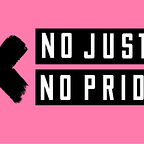DC Pride Protest Exposes Ugliness Still Within LGBTQ Community
The decision of leadership of Capital Pride to ignore requests to center marginalized voices within the LGBTQ2S community and remove Metropolitan Police and corporations who profit from pipelines and war such as Wells Fargo and Lockheed Martin led to a #NoJusticeNoPride protest during yesterday’s Pride parade that exposed continuing divisions within DC’s LGBTQ2S community.
The protesters wanted a more expansive vision for Pride that honored its roots as a protest started by Black and Latinx trans and queer leaders. They took issue with the corporate prominence — especially of companies actively investing in the Dakota Access pipeline and in arms manufacturing — as well as the presence of a police department plagued with issues of violence against DC residents — particularly those who are Black and transgender.
In response to their demands leading up to the event, Pride organizers and others admonished the protesters with calls for “unity.” The events that unfolded today however show that DC’s Gay community must look inward if it aspires to a unity with Black, Latinx, Native, and other marginalized groups within it.
As queer Black women stepped in front of the police to highlight the threat of abuse and state violence that LGBTQ2S people of color experience and a native-led blockade stopped the Wells Fargo float, the crowd reaction exposed the racism still present within the LGBTQ community and showed what protest participants describe as a hollowness to Capital Pride.
Spectators yelled from the sidelines at those involved in the direct action, telling them to “go home” and that “this {pride} is not for them.” Other spectators, inconvenienced by the demonstrations, called on the Metro Police Department to arrest members of No Justice No Pride, so the parade could continue as planned. These reactions made clear that many, predominantly white and cisgender members of the LGBT community do not recognize the needs of LGBTQ2S people of color as valid, worth listening to, or welcome in LGBT spaces.
Not all responses were negative. Many members of the community recognized the need for No Justice No Pride’s demands to be heard and expressed their support for the actions.
After initially refusing to negotiate with No Justice No Pride’s first blockade, members of Capital Pride’s executive board reluctantly approached the second and third blockades, seeking to discuss demands. Negotiations at the Wells Fargo blockade lasted nearly two hours, but representatives of Capital Pride refused to agree to any of No Justice No Pride’s demands. Instead Capital Pride suggested only that that the two groups “meet” to “discuss” ways to address the issues highlighted in the direct actions, echoing what No Justice No Pride has previously referred to as Capital Pride’s attempts to “‘research’ and ‘discuss’ their way out of systematic changes that could actually give power of Pride back to the people whose voice and experience are most crucial to the fight for our rights today.”
###
No Justice No Pride is an ad-hoc collective of organizers and activists from across the District of Columbia. We exist to end the LGBT movement’s complicity with systems of oppression that further marginalize queer and trans individuals. Our members are black, brown, queer, trans, gender nonconforming, bisexual, indigenous, two-spirit, formerly incarcerated, disabled, white allies and together we recognize that there can be no pride for some of us without liberation for all of us.
